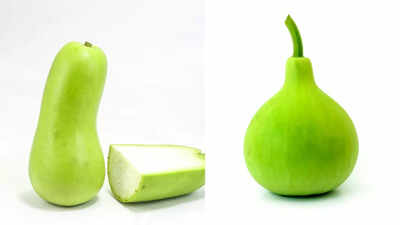ARTICLE AD BOX

Gourds, part of the Cucurbitaceae family, have been cultivated and consumed across the world for centuries due to their versatility and nutritional benefits. Two of the most popular varieties are the long gourd and the round gourd, commonly known as bottle gourd or lauki in South Asian cuisines.
Both are valued for their mild, refreshing flavour, tender flesh, and high water content, which make them ideal for a variety of dishes, from soups and stews to curries and stir-fries. While their nutritional profiles are similar, subtle differences in shape, texture, and culinary use distinguish them. Understanding these differences enables cooks, chefs, and health-conscious individuals to select the right variety for their recipes and dietary goals.
Understanding the difference between a long and a round gourd
Long gourd, as the name suggests, has an elongated cylindrical shape. Its smooth, pale green skin encases tender flesh that is high in water content. This variety is known for its ability to absorb flavours from spices and other ingredients, making it ideal for soups, stews, and curries.
6 Healthiest leafy vegetables (saag) one must eat in this weather
A round gourd, on the other hand, is more spherical or bulbous. Its slightly thicker skin and uniformly tender flesh make it well-suited to similar culinary applications, particularly in dishes that require even cooking or stuffing.
The choice between the two often comes down to availability, personal preference, and the desired presentation in a recipe.
Nutritional comparison between long gourd and round gourd
Both gourds are low in calories and rich in water, making them excellent options for hydration and weight management. They contain modest amounts of carbohydrates and protein, minimal fat, and a good supply of dietary fibre. They are also a source of vitamins and minerals, including vitamin C and potassium.A study published in the Journal of Food Science and Technology highlights that bottle gourd is an excellent source of dietary fibre, protein, carbohydrates, essential fatty acids, and micronutrients
| Feature | Long gourd | Round gourd |
| Shape | Elongated and cylindrical | Spherical or bulbous |
| Flesh | Tender, high water content | Tender, slightly thicker skin |
| Taste | Mild, absorbs flavours easily | Mild, consistent texture |
| Cooking Use | Soups, stews, curries, stir-fries | Soups, stews, curries, stuffing |
| Calories | Very low | Very low |
| Carbohydrates | Low | Low |
| Protein | Low | Low |
| Fat | Minimal | Minimal |
| Dietary fibre | Moderate | Moderate |
| Vitamins and minerals | Vitamin C, potassium | Vitamin C, potassium |
| Hydration | High | High |
Culinary uses
Long gourd is prized for its delicate taste and high water content. It cooks quickly and absorbs flavours well, making it ideal for curries, soups, and stews. Its elongated shape allows for easy slicing into uniform pieces, suitable for stir-fries or stuffed gourd recipes.The round gourd is equally versatile. Its spherical form is ideal for stuffing with spices, rice, or minced vegetables.
The tender flesh cooks evenly and retains moisture, producing consistent texture in dishes such as stews, soups, and mixed vegetable preparations.Both varieties can often be used interchangeably in recipes, with slight adjustments in cooking time to account for size and water content.
Health benefits of gourd
Incorporating gourds into the diet offers multiple health benefits:
- Digestive health: Rich in dietary fibre, both gourds promote regular bowel movements and support gut health.
- Weight management: Low-calorie and high water content make them ideal for weight-conscious diets.
- Hydration: The high water content helps maintain hydration, particularly in warmer climates.
- Heart health: Potassium in gourds may support healthy blood pressure levels.
- Regular consumption of either variety can contribute to overall health and well-being while providing culinary versatility.
Selecting and storing gourds
When choosing gourds, focus on freshness and firmness. Look for smooth, unblemished skin, intact stalks, and a firm texture.
Avoid gourds that feel soft, light for their size, or have signs of bruising or discolouration, as these may indicate overripeness or spoilage.Store gourds in a cool, dry place and consume them within a few days for maximum freshness. For longer storage, they can be refrigerated, but it is best to prepare and cook them soon after purchase to retain texture and flavour.
Long gourd or round gourd: Which should you choose
Both long and round gourds offer unique advantages. Long gourd may be preferable for dishes requiring elongated slices or quick cooking, while round gourd is ideal for stuffing or uniform cooking.
Nutritionally, they are very similar, so the choice is largely based on culinary needs and personal preference.Including both varieties in your diet allows for experimentation with texture, flavour, and presentation, while ensuring a range of nutrients and health benefits.Disclaimer: This article is for informational purposes only and should not be considered medical advice. Please consult a healthcare professional before making any changes to your diet, medication, or lifestyle.Also read | Ice cream for people with diabetes: Know its effects on blood sugar and smart consumption tips

 11 hours ago
4
11 hours ago
4









 English (US) ·
English (US) ·